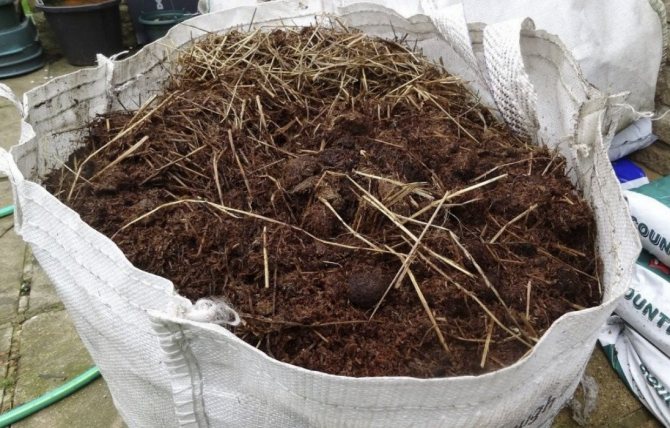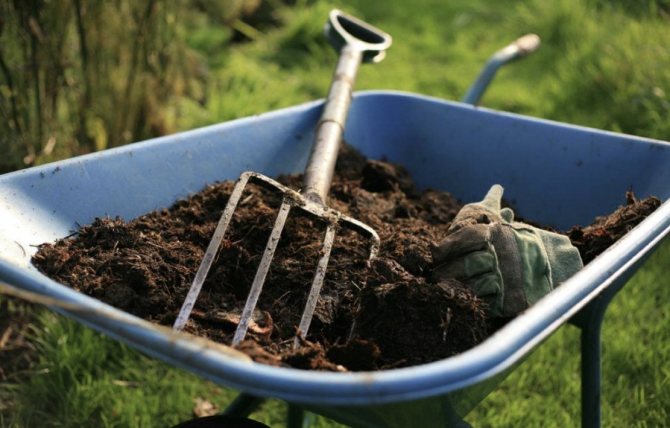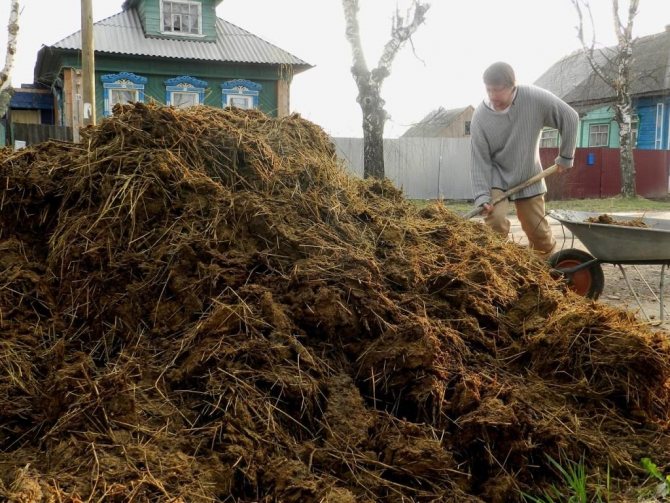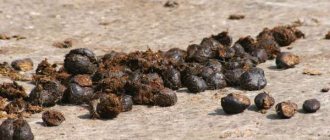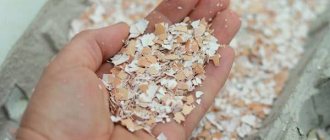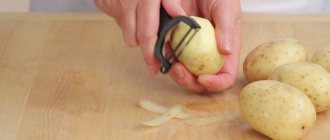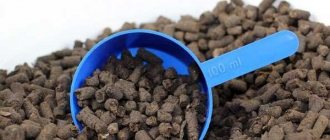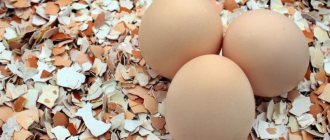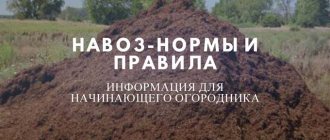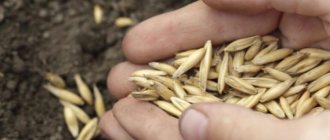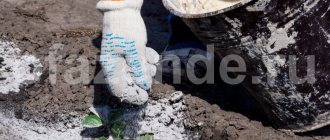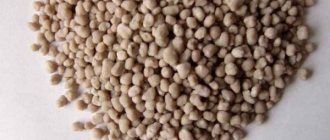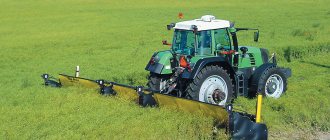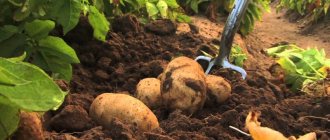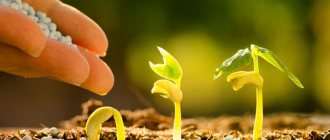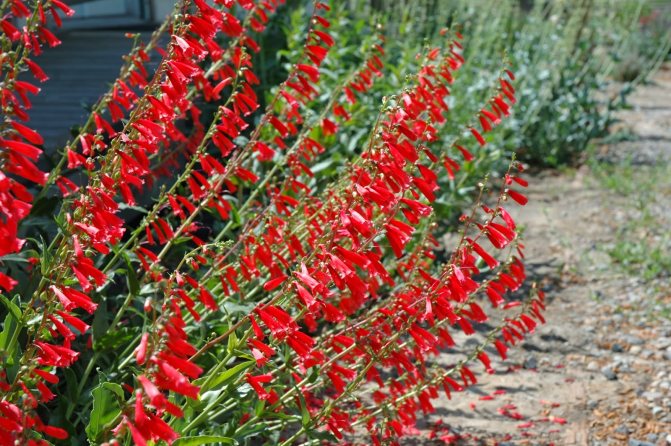
The most environmentally friendly organic fertilizer today is cow dung. It is the most versatile, widespread and available biological material for almost all gardeners. Cow dung is used fresh as fertilizer and for making more efficient fertilizers. It is widely used in agricultural technology for growing absolutely all vegetable, fruit and berry and ornamental crops.
Benefits and composition
One of the most affordable organic fertilizers at home is cow humus. The formation of a fertile soil layer occurs due to the introduction of cow dung into it. The main difference between organic and mineral fertilizers is that they contribute to the accumulation of nutrients in the soil.
The soil enriched with mullein or fertilizers based on it increases the aeration capacity of the soil. Thus, it contributes to a beneficial effect on the correct development of the root system of plants. This impact leads to rapid growth and high productivity of fruit, vegetable and berry crops. The effective action of organic fertilizers can last up to 4-6 years.
In its composition, mullein contains many nutrients and minerals necessary for the proper development and fruiting of horticultural crops.
Mullein composition for 1 kg:
- 1.4 g of potassium oxide;
- 3 grams of phosphorus oxide;
- 2.9 grams of calcium oxide;
- 3.5 grams of nitrogen.
The readings of the chemical composition of manure can vary depending on the diet of the animal and its age. To start using the fertilizer for its intended purpose, you need to study in more detail what cow dung is as a fertilizer and how to use it correctly.
And there is manure in "tablets"?
Fertilizer producers today offer compressed, or granular, manure with an effect similar to that of a natural “product”. Such fertilizer will not pollute your hands and will not spoil the air. It's a pleasure to work with him! Granular manure will help out even if access to natural fertilizer is limited or absent. It is easy to use and versatile, and the level of usefulness is not inferior to the natural "analogue", since it also contains nitrogen, phosphorus, potassium and magnesium.
Conscientious growers, as a rule, purify the feedstock from impurities and inclusions, including pathogenic bacteria and weed seeds, and the plants receive only a balanced complex of nutrients plus growth stimulants. An additional "bonus" of such fertilizers is the improvement of the soil and an increase in its fertility.
The inhabitants of the Moscow Zoo annually produce more than 4 thousand cubic meters of manure, including "exotic". This amount of excrement can accommodate about 700 trucks.
Varieties and classification
Mullein is an organic fertilizer that has a beneficial long-term effect on horticultural crops. It acts slowly, but evenly and for a long time. In addition, this organic is available to almost all gardeners. But in order to properly use the fertilizer for its intended purpose, it is necessary to consider its classification.
The mullein is divided into 2 fertilization states, each of which, in turn, is subdivided into several types.All types have their own distinctive characteristics, which you should familiarize yourself with. Mullein is classified by moisture content and degree of decomposition.
Using wood ash as plant fertilizer
According to the moisture content in the composition, the species are divided:
- up to 80% moisture in the composition - the solid consistency of a mullein. Easily explained by the characteristics of the litter. Her animal can be eaten with straw. The litter, in this case, most likely consists of sawdust, foliage, or peat chips;
- 80-90% - semi-liquid consistency of manure;
- more than 90% - slurry.
Varieties of mullein in terms of moisture content can be used for their intended purpose in solutions with water or must be sent for processing in order to obtain humus. Usually, it is more customary to divide cow dung as a fertilizer at home according to the degree of decomposition of the product.
According to the degree of decomposition, there are types:
- fresh - has a weakly expressed structure of decomposition and is not of particular value in agricultural technology;
- semi-overripe - formed by proper storage for 3 months. In appearance, it is much darker than fresh, and has a looser consistency interspersed with straw;
- humus is a dark, loose structure that crumbles perfectly. Humus is loaded with a huge amount of trace minerals and easily digestible nutrients. It is a valuable product. Formed within 6 months of correct storage.
All varieties of mullein can be used in the garden, but you need to know exactly how to apply this or that type correctly, without prejudice to your future harvest.
Using the mullein for plants
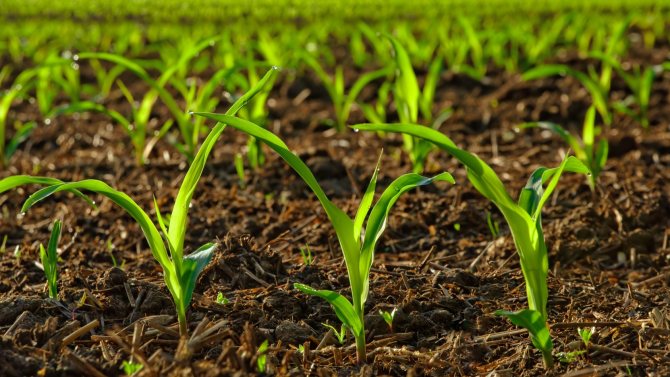

When watering vegetable plants, a liquid, non-concentrated solution is made and a bucket of water is watered per square of the plot. And watered with this fertilizer:
All types of cabbage, beets, lettuce, eggplant, tomatoes, cucumbers, squash, peppers.
Before flowering, and later for the formation of ovaries, superphosphate is added to such a solution. Its properties will help the plant in setting and ripening fruits.
Plants that should not be watered abundantly with mullein solution, since they do not like nitrogen, and can "heal", that is, you will not wait to go into the tops and root crops. These are such cultures as:
Kohlrabi cabbage, turnip, onion, carrot, radish, garlic.
Indications and contraindications for use
Almost all horticultural plants respond well to feeding a natural product. But it is worth noting that the feeding of each fruit crop must be approached individually. Each plant has its own requirements for the direct introduction of organic matter into the soil. Therefore, it is used in various forms.
Cow dung is used:
- fresh;
- in liquefied;
- in granules;
- as a dry substrate.
It should be noted that the use of fresh mullein is not recommended. This is because it contains a high concentration of ammonia. By introducing it in this form, you can harm the root system of the plant. Therefore, it is advisable to dilute it with water. Use fresh manure in the soil only in the fall, when preparing it for the next gardening season.
Features of potassium salt and its properties
Fresh
The fresh product can be used to prepare "warm" beds. Usually they are made from fresh manure with a height of 1 m. The manure helps to warm the soil inside the garden to +55 degrees. The construction of fresh produce has a beneficial effect on the accelerated development and growth of fruit crops during early spring.
Dry substrate
The most convenient form for using manure is a dry substrate. This state of mullein is achieved naturally. To do this, it must be properly preserved for 1.5-2 years.After the expiration of this period, it acquires a dry, free-flowing structure that is odorless and moisture-free.
The structure of the material allows you to significantly save on its consumption. In addition, the use of a dry substrate allows you to plant crops immediately after it is introduced into the soil. Dry fertilizer should not contain moisture. If during the fertilization process it turns out that it contains some amount of moisture, this means that the product has not reached its readiness and so far it is not recommended to use it as such. It is best to wait 1 more season until it is completely dry.
Liquid fertilizer
To get high-quality and safe fertilizer in liquid form, you need to dilute fresh manure with water. The composition of fresh biological material includes eggs of various parasites. You can get rid of them using the method of diluting manure in water. In addition, the water completely removes the pungent ammonia odor of the product. There are 2 ways to use liquid cow dung.
Ways to use liquid fertilizer:
- Root dressing is the main type of fertilizer in liquid form. Fertilizer is applied to the soil under the very roots of the plant.
- Spraying is carried out with a very weak solution of the aerial part of the weakened plant.
A diluted mullein solution promotes the rapid activation of all processes of the plant's full life.
Granular form
Fertilizer in granules is obtained by biological treatment and subsequent pressing. This form is convenient because the root system of the plant with the help of granules can receive nutrients and trace elements in portions throughout the season.
The drug Heteroauxin: instructions for use
When watering, granules are able to absorb moisture and gradually give it to the soil along with useful substances. In addition, the granules are able to maintain the required moisture level, preventing the soil from drying out.
Granular fertilizer is applied to the soil only in the fall during the preparation of the soil for winter. In spring, the granules are sprinkled on the soil surface. Each form of mullein fertilizer has a different purpose. The beneficial effect of manure on the growth and productivity of plants does not affect the form of its use.
Like all fertilizers, manure has some contraindications for use. Therefore, before using a product based on cow dung, it is necessary to familiarize yourself with the conditions under which it must absolutely not be used.
A lot of chemical reactions take place in a fresh product that can negatively affect the root system of a plant, therefore, it is not recommended to use it in this form for its intended purpose. In addition, the live eggs of parasites in fresh feces are very dangerous both for the plant and for human health.
Often a white bloom can be observed on a pile of manure. This indicates fungal infections. It is also impossible to use such a product, especially for "warm" beds. You can get rid of fungal plaque only by drying the product with further proper storage.
Before applying manure top dressing, you should familiarize yourself with the characteristic features of growing fruit plants. It should be noted that some of them categorically do not tolerate it. For example, vegetables such as beets, celery, radishes and carrots do not respond well to such fertilizers. Therefore, in order to fertilize the soil for these plants, organic fertilizing should be applied to the soil 1-2 years before planting in a certain place.
The richest source of nutrients
A large number of nutrients are found in horse and cow manure, as well as in poultry manure. Less - in pork, sheep, rabbit.There are many nutrients in fresh manure, but over time, overheating, it turns into a more valuable material, since trace elements pass into a form that plants can more easily assimilate. Fresh faeces are introduced into the aisles only in the form of a diluted slurry several times.
The impact of organic matter depends on the type of soil and on the availability of sufficient moisture for its decomposition and assimilation by plants:
- horse organics release nutrients throughout the year;
- cow dung nourishes the soil for 3 years;
- other species also decompose within a few years.
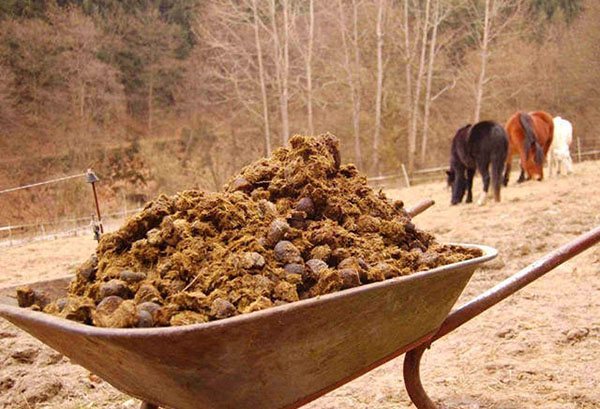

Methods and features of processing
The quality of the future fertilizer depends on the correct storage and processing of the cow's waste product. Competent processing consists of several stage processes, each of which is very important and it is absolutely impossible to violate it.
What fertilizers are best for indoor plants
Processing stages:
- Collection of the product using pumping equipment or a mechanical method.
- Correct storage.
- Timely disposal.
Processing is carried out naturally or with the introduction of special ready-made bacteria into the manure. For proper processing, manure is stacked in dense heaps, which provides an optimal temperature for the natural decomposition of the waste product.
Further, the semi-rotten mass is transferred to other heaps, while it is tamped a little denser, sprinkled with peat crumbs. In this form, humus does not lose nitrogen. After 2 months, rotted manure becomes full-fledged humus.
Recently, a method with the addition of bacterial cultures has been more commonly used, which helps to speed up and make the process much better. The bacterial process is completely harmless to absolutely all agricultural crops and does not pose a danger to human health.
Description of natural fertilizer
One of the most common ways to improve the quality and nutritional value of the soil is to apply manure. Cow dung is very popular with gardeners. It is affordable and healthy for plants.
The mullein is suitable for almost all types of soil. Regular application of such top dressing contributes to the improvement of soil quality, active development of agricultural crops and obtaining a rich harvest.
On an agricultural scale, mullein is of great value. Thanks to him, crop yields increase, the immune system of plants is strengthened, which reduces the risk of developing serious pathological processes.
Cow manure is actively used in small summer cottages, as well as garden plantations. Many agricultural crops (with the exception of some plant species), as well as garden flowers, prefer to "feast on" manure. It is advisable to periodically introduce organic fertilizing into the soil of indoor plants, but many growers refuse this method due to the specific smell of the mullein.
Self-production
To get the most out of using organic fertilizers in your vegetable garden or garden, it is recommended that you follow simple organic rules and requirements.
Rules and requirements:
- directly before sowing or planting seedlings, it is absolutely impossible to introduce fresh organic matter. Due to the chemical reactions taking place in it, the root system of plants may die;
- The mullein processing process will be much more efficient if you apply fertilizer to the soil after harvesting in the fall. In this case, after fertilization, the soil must be dug up together with the mullein;
- in the process of fertilization, one should adhere to standard norms: it is recommended to apply 3-4 kg of manure per 1 sq / m of soil;
- it is necessary to fertilize the soil once every 2-3 years. With such a fertilization schedule, the soil is not depleted and retains the yield of all fruit, vegetable and ornamental crops;
- rotted or dry humus should be used in spring as mulch in the beds and tree trunks of fruit crops.
The optimal use of the cow's waste product would be to use the mass that has been processed for more than 2 years.
The advantages of organic fertilizers are obvious: a natural, environmentally friendly fertilizer is perfect for efficient soil nutrition and natural protection.
Is it true that manure is dangerous?
Due to the high concentration of nitrogen, manure is the main cause of leaf and root burns. Used undiluted, it can kill even the toughest green pets. Fresh manure, especially cow manure, should not be used. It can contain not only putrefactive bacteria and fungal spores, but also many weed seeds, which will easily germinate and hinder the development of cultivated plants.
In addition, the acidity level (pH) of all types of manure is 7-8, which is not suitable for growing healthy and strong plants. Therefore, for each type of excrement, the consumption rates and the degree of dilution are strictly defined.
Regulation of the rate of application of organic matter
It is possible to control the volume of liquid manure introduction into the root layers of the soil using the following methods:
- Determination of the productivity of a pumping station engaged in pumping organic matter from storage directly to the field. The speed of movement of equipment during calculations is kept constant until the completion of measurement activities.
- Measuring the speed of the machine towing the cultivator. In this case, the capacity of the pumping station is unchanged. The slower the tractor travels across the field, the higher the fertilizer application rate per square meter of surface.
In practice, the operating conditions of the equipment and the productivity of the pumping station are not constant, therefore, it is advisable to regulate the rate of application of liquid manure by determining the speed of movement of the equipment.
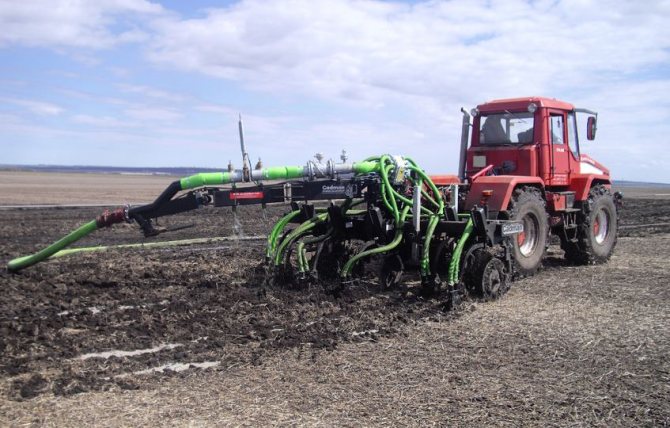

Benefits of subsoil injectors
These versatile machines have the following advantages:
- Simultaneously with the introduction of organic matter, the unit performs the function of soil preparation.
- The introduced manure has little contact with the air, which significantly reduces the loss of nutrients. For the same reason, the introduction of organic matter is accompanied by a minimal spread of odors.
- The applied fertilizer remains within the boundaries of the cultivated field, runoff into adjacent territories is not allowed.
- The units perform functions in full compliance with the requirements of environmental safety.
- A huge selection of options for working tools allows you to complete equipment that goes into the field to work on any, even the most difficult soil.
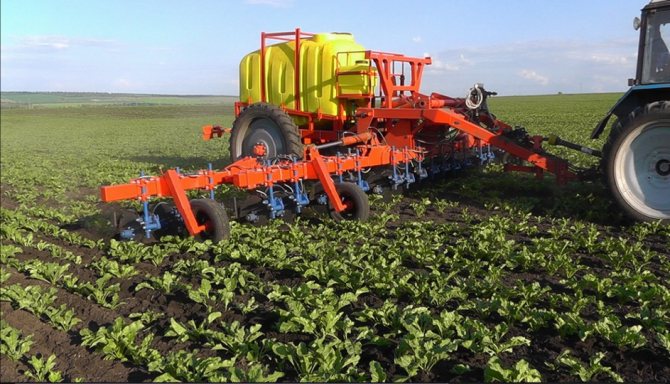

Receiving
In livestock farms, the total fecal runoff is released into concrete pits or wells. Under the pressure of the compacting and settling mass, its liquid part is squeezed upward. The slurry is pumped out, stored for some time (maximum - from autumn to spring), and scattered in pairs with aggregates of the types АНЖ, РЖ, etc. The settled manure is raked out and piled into heaps for re-handling. In large farms, 2 or more sewage basins are made, the drain into which is bypassed; in this case, the manure will flow directly into the "squeezed out" pit.
In a similar way, slurry can be obtained in private household plots with pets, but in small farms the disadvantages of this method are fully manifested:
- labor intensity and cost of the waste collection device;
- sanitary and hygienic problems: protective zone of manure sedimentation tanks - 150 m;
- huge losses of nitrogen, since the ratio of the area of its losses in a) with a decrease in the size of the sump falls squarely, and the volume of slurry in it - cubes.
The easiest way to get slurry in small private farms is to dilute the manure for feeding and drain the sludge.A bucket or barrel is filled 1 / 3-1 / 4 with steam manure, mix well, wait until the chatterbox settles (1-3 hours), and the liquid is drained - this is fresh slurry. The container with it is covered from dust and debris and left for several days in the shade away from residential buildings, recreation areas, a playground, etc. On days 2-3, the ammonia smell will increase sharply (urine "sour"), then it weakens - the slurry is ready, you can use it.
A more perfect way, suitable for private household plots, is not to defend the urine, but to strain it out, while the loss of nitrogen and the amount of residual ammonia in the slurry are greatly reduced. The diagram of the installation for draining slurry from the total slurry is shown in Fig. If manure is provided by a cow or several of them, it is better to make a couple or 3 units; completely squeezed out manure from the filled one is first scooped out or pulled out together with the bag and laid out in a heap for maturing.
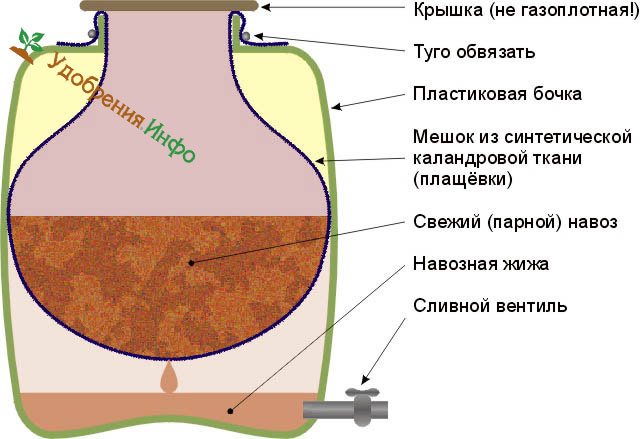

Diagram of a home-made installation for draining slurry from steam manure
Note: slurry from such an installation can only be applied diluted (see below) due to the higher concentration of nutrients in it.
Which manure is better?
In private household plots, it is completely unacceptable to receive and use slurry from pig manure: in it, without complex special processing, pathogens and helminth eggs, incl. such dangerous as brain tapeworm and blood fluke. Against the background of their invasions, trichomoniasis is relegated to the second echelon in terms of lethality. Recently, it has been revealed that, in terms of the degree of danger, the dung of nutria is comparable to pig manure. These types of animal waste need to be dumped in pits for re-handling for at least a year: the high temperature will kill most pathogens, and the rest will be killed by air and light.
As for the feces of other domestic animals, it is possible to squeeze out or strain out the slurry from their mixture. Also recently revealed a high nutritional value for plants of rabbit droppings. It is dry by itself, but it can be added to cow's so that the strained slurry will turn out to be more fluid and rich in nutrients. If there is a choice - what kind of manure to use - then horse and sheep loosen heavy clay soils, and cow, on the contrary, somewhat compresses loose, excessively permeable soils and increases their exchange moisture capacity.

